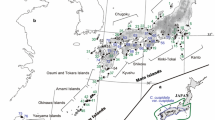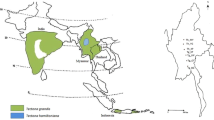Abstract
Subtropical forests in China constitute the major expanse of evergreen broad-leaved forest in East Asia. The significant genetic divergence of the keystone tree species should be expected due to the huge geomorphological and environmental changes from west to east in subtropical China. In this study, a total of 652 individuals from 27 populations of Castanopsis fargesii throughout its natural range in mainland China were genotyped with eight chloroplast microsatellite markers to investigate genetic diversity, population differentiation, and demographic history of C. fargesii. Phylogeographic structure among populations of C. fargesii was evidenced by the permutation test, revealing that NST was significantly higher than GST . The strong genetic differentiation found among populations was well in accordance with isolation-by-distance model. In addition, significant isolation by elevation was detected among populations. Significant genetic differentiations were revealed among the west, center, and east regions by approximate Bayesian computations (ABC). The genetic divergence might reflect the regional responses to the fast and dramatic uplift of Yunnan-Guizhou Plateau and Wuyi mountain range in the Pleistocene. In the present study, contraction-expansion process was detected in the west, center, and east regions, indicating that geomorphological remodeling together with climatic changes in the Pleistocene had strong impact on genetic structure of C. fargesii.



Similar content being viewed by others
References
Bandelt HJ, Forster P, Röhl A (1999) Median-joining networks for inferring intraspecific phylogenies. Mol Biol Evol 16:37–48, Software NETWORK available at http://www.fluxus-engineering.com
Cannon CH, Manos PS (2003) Phylogeography of the Southeast Asian stone oaks (Lithocarpus). J Biogeogr 30:211–226
Cao BX (1990) The quaternary climate and the future climate and environmental change in China. Reg Geol China 2:97–111
Chen XS, Li QJ (2008) Patterns of plant sexual systems in subtropical evergreen broad-leaved forests in Ailao Mountains, SW China. J Plant Ecol 1:179–185
Chen JY, Zhou XD (1993) Relationship between palaeoenvironmental change and soil development in Wuyi Mountains. Geol Fujian 12:228–231
Cornuet JM, Santos F, Beaumont MA, Robert CP, Marin JM, Balding DJ, Guillemaud T, Estoup A (2008) Inferring population history with DIY ABC: a user-friendly approach to approximate Bayesian computation. Bioinformatics 24:2713–2719
Deguilloux MF, Dumolin-Lapègue S, Gielly L, Grivet D, Petit RJ (2003) A set of primers for the amplification of chloroplast microsatellites in Quercus. Mol Ecol Notes 3:24–27
Doyle JJ, Doyle JL (1987) A rapid DNA isolation procedure for small quantities of fresh leaf tissue. Phytochem Bull 19:11–15
Eckert CG, Samis KE, Lougheed SC (2008) Genetic variation across species’ geographical ranges: the central-marginal hypothesis and beyond. Mol Ecol 17:1170–1188
Excoffier L, Laval G, Schneider S (2005) Arlequin ver. 3.0: an integrated software package for population genetics data analysis. Evol Bioinform Online 1:47–50
Fan DM, Yue JP, Nie ZL, Li ZM, Comes HP, Sun H (2013) Phylogeography of Sophora davidii (Leguminosae) across the “Tanaka-Kaiyong Line”, an important phytogeographic boundary in southwest China. Mol Ecol 22:4270–4288
Fu YX (1997) Statistical tests of neutrality of mutations against population growth, hitchhiking and background selection. Genetics 147:915–925
Gao LM, Möller M, Zhang XM, Hollingsworth ML, Liu J, Mill RR, Gibby M, Li DZ (2007) High variation and strong phylogeographic pattern among cpDNA haplotypes in Taxus wallichiana (Taxaceae) in China and North Vietnam. Mol Ecol 16:4684–4698
Grivet D, Deguilloux MF, Petit RJ, Sork VL (2006) Contrasting patterns of historical colonization in white oaks (Quercus spp.) in California and Europe. Mol Ecol 15:4085–4093
Harrison SP, Yu G, Takahara H, Prentice IC (2001) Diversity of temperate plants in East Asia. Nature 413:129–130
Huang CJ, Bruce B (1999) Fagaceae. In: Flora of China, vol 4. Science Press, Beijing, pp 315–333
Jensen J, Bohonak A, Kelley S (2005) Isolation by distance, web service. BMC Genet 6:13
Jin JH, Liao WB, Wang BS, Peng SL (2003) Global change in Cenozoic and evolution of flora in China. Guihaia 23:217–225
Lei M, Wang Q, Wu ZJ, López-Pujol J, Li DZ, Zhang ZY (2012) Molecular phylogeography of Fagus engleriana (Fagaceae) in subtropical China: limited admixture among multiple refugia. Tree Genet Genomes 8:1203–1212
Li J, Ge XJ, Cao HL, Ye WH (2007) Chloroplast DNA diversity in Castanopsis hystrix populations in south China. For Ecol Manag 243:94–101
Li J, Zheng Z, Huang KY, Yang SX, Chase B, Valsecchi V, Carré M, Cheddadi R (2012) Vegetation changes during the past 40,000 years in central China from a long fossil record. Quat Int. doi:10.1016/j.quaint.2012.01.009
Liu MQ, Zhou ZK (2006) Modern and geological distribution of Castanopsis (Fagaceae). Acta Bot Yunnanica 28:223–235
Liu RL, Wang L, Du TZ (2008) Features of population ecological quantity field of Castanopsis fabri community in Jinggang Mountain. Sci Silvae Sin 44:1–7
Liu J, Moller M, Provan J, Gao LM, Poudel RC, Li DZ (2013) Geological and ecological factors drive cryptic speciation of yews in a biodiversity hotspot. New Phytol. doi:10.1111/nph.12336
Luo D, Xiao YF, Zhan L, Zhang L (2010) The tectogenesis control of Danxia landform in southeast China. J East China Inst Technol 33:147–153
Ming LR (1987) Some problems about the Quaternary geology of China. Bull Inst Geol Chin Acad Geol Sci 17:129–139
Nettel A, Dodd RS, Afzal-Rafii Z (2009) Genetic diversity, structure, and demographic change in tanoak, Lithocarpus densiflorus (Fagaceae), the most susceptible species to sudden oak death in California. Am J Bot 96:2224–2233
Ni J, Yu G, Harrison SP, Prentice IC (2010) Palaeovegetation in China during the late Quaternary: biome reconstructions based on a global scheme of plant functional types. Palaeogeogr Palaeoclimatol Palaeoecol 289:44–61
Pakkad G, Ueno S, Yoshimaru H (2008) Genetic diversity and differentiation of Quercus semiserrata Roxb. in northern Thailand revealed by nuclear and chloroplast microsatellite markers. For Ecol Manag 255:1067–1077
Pardo C, Cubas P, Tahiri H (2008) Genetic variation and phylogeography of Stauracanthus (Fabaceae, Genisteae) from the Iberian Peninsula and northern Morocco assessed by chloroplast microsatellite (cpssr) markers. Am J Bot 95:98–109
Petit RJ, El Monsadik AE, Pons O (1998) Identifying population for conservation on the basis of genetic markers. Conserv Biol 12:551–558
Pons O, Petit RJ (1996) Measuring and testing genetic differentiation with ordered versus unordered alleles. Genetics 144:1237–1245
Qiu YX, Fu CX, Comes HP (2011) Plant molecular phylogeography in China and adjacent regions: tracing the genetic imprints of Quaternary climate and environmental change in the world’s most diverse temperate flora. Mol Phylogenet Evol 59:225–244
Ravelo AC, Andreasen DH, Lyle M, Lyle AO, Wara MW (2004) Regional climate shifts caused by gradual global cooling in the Pliocene epoch. Nature 429:263–267
Rogers AR, Harpending H (1992) Population growth makes waves in the distribution of pairwise genetic differences. Mol Biol Evol 9:552–569
Schneider S, Excoffier L (1999) Estimation of past demographic parameters from the distribution of pairwise differences when the mutation rates vary among sites: application to human mitochondrial DNA. Genetics 152:1079–1089
Sebastiani F, Carnevale S, Vendramin GG (2004) A new set of mono- and dinucleotide chloroplast microsatellites in Fagaceae. Mol Ecol Notes 4:259–261
Song YC, Chen XY, Wang XH (2005) Studies on evergreen broadleaved forests of China: a retrospect and prospect. J East China Normal Univ (Nat Sci) 1:1–8
Tajima F (1989) Statistical method for testing the neutral mutation hypothesis by DNA polymorphism. Genetics 123:585–595
Tang CQ, Ohsawa M (2009) Ecology of subtropical evergreen broad-leaved forests of Yunnan, southwestern China as compared to those of southwestern Japan. J Plant Res 122:335–350
Tang GB, Zhang JP, Yang XD, Luo BX, Wang YZ (1994) Late cenozoic palynoflora and environment changes in Yunnan-Guizhou Plateau. Mar Geol Quat Geol 14:91–104
Wang XH, Kent M, Fang XF (2007) Evergreen broad-leaved forest in Eastern China: its ecology and conservation and the importance of resprouting in forest restoration. For Ecol Manag 245:76–87
Weir BS, Cockerham CC (1984) Estimating F-statistics for the analysis of population structure. Evolution 38:1358–1370
Weising K, Gardner RC (1999) A set of conserved PCR primers for the analysis of simple sequence repeat polymorphisms in chloroplast genomes of dicotyledonous angiosperms. Genome 42:9–19
Yan HF, Zhang CY, Wang FY, Hu CM, Ge XJ, Hao G (2012) Population expanding with the phalanx model and lineage split by environmental heterogeneity: a case study of Primula obconica in subtropical China. PLoS ONE 7:e41315. doi:10.1371/journal.pone.0041315
Yan F, Zhou WW, Zhao HT, Yuan ZY, Wang YY, Jiang K, Jin JQ, Murphy RW, Che J, Zhang YP (2013) Geological events play a larger role than Pleistocene climatic fluctuation in driving the genetic structure of Quasipaa boulengeri (Anura: Dicroglossidae). Mol Ecol 22:1120–1133
Yang HJ, Xin X, Li GS (1989) The causal mechanism of Quaternary environmental changes in China. Quat Sci 2:97–111
Yu G, Chen X, Ni J, Cheddadi R, Guiot J, Han H, Harrison SP, Huang C, Ke M, Kong Z, Li S, Li W, Liew P, Liu G, Liu J, Liu KB, Prentice IC, Qui W, Ren G, Song C, Sugita S, Sun X, Tang L, van Campo E, Xia Y, Xu Q, Yan S, Yang X, Zhao J, Zheng Z (2000) Palaeovegetation of China: a pollen data-based synthesis for the mid-Holocene and last glacial maximum. J Biogeogr 27:635–664
Zhang DF, Fengquan L, Jianmin B (2000) Eco-environmental effects of the Qinghai-Tibet Plateau uplift during the Quaternary in China. Environ Geol 39:1352–1358
Zhang TS, Li K, Wang Q, Cai YL, Yang K, Chen LQ (2006) Seed predation and dispersal of Castanopsis fargesii by rodents in Tiantong Mountain, Zhejiang province. Chin J Ecol 25:161–165
Zhang ZY, Wu R, Wang Q, Zhang ZR, López-Pujol J, Fan DM, Li DZ (2013) Comparative phylogeography of two sympatric beeches in subtropical China: species-specific geographic mosaic of lineages. Ecol Evol 3:4461–4472
Acknowledgments
We thank three anonymous reviewers for their critical comments. This study was financially supported by the National Natural Science Foundation of China (31170512, 30871959, and 31370668), and by the Knowledge Innovation Program of the Chinese Academy of Sciences (KSCX2-EW-J-28).
Author information
Authors and Affiliations
Corresponding author
Additional information
Communicated by A. Kremer
Electronic supplementary material
Below is the link to the electronic supplementary material.
Figure S1
Posterior (green) and prior (red) of each parameter in approximate Bayesian computations (ABC). T1 and T2 are the time of two divergent events. Tbn_r and Tex_r are the time of bottleneck and expansion duration in a recent event. Tnt is time of an ancestral population before T2 event. N1, N2 and N3 are the effective population size of East, Center and West region respectively. NT is the effective population size of the ancestral population. Nbn_r and Nex_r are effective population size of bottleneck and expansion in a recent event. Tbn and Tex are the time of bottleneck and expansion duration in an ancient event. Nbn and Nex are effective population size of bottleneck and expansion in an ancient event. (GIF 323 kb)
Table S1
(DOC 40 kb)
Table S2
(DOC 73 kb)
Table S3
(DOCX 18.2 kb)
Rights and permissions
About this article
Cite this article
Sun, Y., Hu, H., Huang, H. et al. Chloroplast diversity and population differentiation of Castanopsis fargesii (Fagaceae): a dominant tree species in evergreen broad-leaved forest of subtropical China. Tree Genetics & Genomes 10, 1531–1539 (2014). https://doi.org/10.1007/s11295-014-0776-3
Received:
Revised:
Accepted:
Published:
Issue Date:
DOI: https://doi.org/10.1007/s11295-014-0776-3




